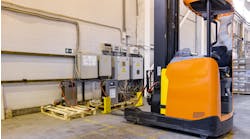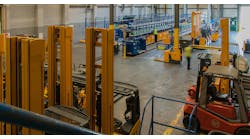The U.S. government has established guidelines, through executive order, for its departments to request certain levels of recycled content within products when making purchases. If civilian companies would adopt these same guidelines, theoretically the demand for recycled material should increase. The final comprehensive procurement guidelines (CPG) and final recovered material advisory notice (RMAN) along with executive order 12873 run hundreds of pages, including three pages needed to define acronyms. Here’s an edited version of these documents to get you thinking about how your company can work recycled packaging content into its purchases. I’ll focus on pallets, specifically.
Defining the issue
These government documents contain discussions and recommendations on the recovered material content levels and post-consumer material content levels at which the designated items are generally available. The terms "post-consumer material" and "recovered material" are defined in 40 CFR 247.3.
Post-consumer material means a material or finished product that has served its intended end use and has been diverted or recovered from waste destined for disposal, having completed its life as a consumer item. Post-consumer material is part of the broader category of recovered material.
Recovered material means waste material and byproducts which have been recovered or diverted from solid waste. The term does not include those material and byproducts generated from, and commonly used within the original manufacturing process.
Section 6002(e) of RCRA (or the Act) requires the Environmental Protection Agency (EPA) to designate items that are or can be made with recovered material and to recommend practices to assist procuring agencies in meeting their obligations with respect to the procurement of designated items under RCRA section 6002.
After EPA designates an item, RCRA requires that each procuring agency, when purchasing a designated item, must purchase that item composed of the highest percentage of recovered material practicable.
EPA also considers price as a factor affecting the availability of an item. The price of products, whether made from virgin raw material or recovered material, is affected by many variables. In addition, price may vary depending on whether the product is a common stock item or whether it requires a special order. Price also can be affected by the geographical location of the purchaser, because some products are not uniformly available throughout the United States. The best sources of current price information, therefore, are the manufacturers and vendors of the recycled products.
Relative prices of recycled products compared to prices of comparable virgin products also vary. In many cases, recycled products may be less expensive than their virgin counterparts. While price is a consideration, in most cases, it is not a determining factor when selecting items for designation. It becomes a determining factor only when EPA obtains evidence that the relative price of an item with recovered material content is significantly higher than the relative price of a comparable virgin product.
Pallets
In the section relative to pallets, EPA designates the following levels of recovered material:
• Wood — 95 percent to 100 percent;
• Plastic — post-consumer content 100 percent;
• Thermoformed/Plastic lumber pallets — post-consumer content 25 to 50 percent;
• Paperboard — post-consumer content 50 percent.
During the documents comments phase, EPA received two comments (from the same party) regarding the recovered material content differences between plastic lumber pallets and thermoformed plastic pallets. The commenting party recommended EPA lower the recommended content level for plastic pallets to account for the lower levels used in thermoformed plastic pallets. EPA conducted additional research into the use of recovered material in plastic pallets. Based on this information, EPA believes that it is better to recommend different content levels for plastic lumber and thermoformed plastic pallets.
Sorting out post-consumer material
EPA’s thinking runs along these lines: There are two major types of plastic pallets — plastic lumber pallets and thermoformed plastic (sheeted plastic formed over a mold). There are concerns regarding load capacity, flexibility and durability of both types of plastic pallets, particularly when heavier loads are applied. However, both types of plastic pallets are used by private sector organizations, and the USPS developed a specification for and uses thermoformed plastic pallets.
In its research, EPA noted that, while most manufacturers of plastic lumber pallets used 100 percent post-consumer material, several manufacturers of thermoformed plastic pallets used 25 to 50 percent post-consumer material. EPA has concluded that these two types of pallets should be viewed as two different products.
The question of injection molded and other methods of manufacturing were not discussed in this document.
Plastic, wood and corrugated containers constitute a significant component of the municipal solid waste stream. The National Wooden Pallet and Container Association (NWPCA) estimates that there are some 2,000 different designs of wooden pallets and a variety of sizes. The U.S. Forest Service's Brooks Forest Products Center in Blacksburg, Virginia, tests new and recycled wooden pallets collected across the United States. The center groups recycled pallets into A, B and C categories, with A pallets being the highest quality and requiring the least repair.
The center tests the pallets both by subjecting them to pressure in a large press and by simulating actual pallet use. In the press test, A pallets perform better than new ones, B pallets perform as well as new ones, and C pallets perform worse than new ones. When recycled pallets are subjected to tests simulating actual uses, however, the recycled pallets do not perform as well as new pallets.
The Defense Depot Susquehanna, Pennsylvania (DDSP) has been remanufacturing wooden pallets and using remanufactured wooden pallets for several years. DDSP uses about 12,000 to 14,000 pallets per month, 2,000 of which are remanufactured pallets. Users have been pleased with the remanufactured pallets and high-ranking officials recognize and support their use. According to the U.S. Army Logistics Support Activity Packaging, Storage, and Containerization Center (LOGSA PSCC), whose laboratory is currently testing and evaluating several remanufactured wood pallets designs provided by DDSP, remanufactured pallets, achieve a reasonable performance level when tested with light (1,500 pound) military loads. They are considered unacceptable for extensive field operations and extended use in the military supply system. For example, Army and Marine Corps helicopter lift and Navy ship-to-ship transfer operations require a full military load performance capability to achieve successful military distribution goals. DDSP anticipates that remanufactured wood pallets can be successfully used in predictable distribution operations that require minimal handling, transportation, and short-term storage.
The U.S. Army LOGSA PSCC testing laboratory, at the request of DDSP, is attempting to develop a pallet requirements/performance document using the recently promulgated American Society of Mechanical Engineers (ASME)/American National Standards Institute (ANSI) MH1.8M standard, titled "Wood Pallets", as the base document for the military remanufactured wood pallet. The military requirements will be included as an appendix to the ASME document, subject to final approval by the military services and ASME/ANSI standards committee.
The Center also tests plastic pallets submitted by industry for potential military use. The Center conducted test projects on HDPE pallets in 1994 and 1995. The tests included rough-handling, free-fall drop tests, compressive load tests, and other tests. The Center found that HDPE did not meet military requirements for a distribution pallet.
The pallets tests were provided by suppliers from production runs and the percentage of recovered HDPE content was not known. The tests addressed performance for military use only and did not address performance for non-military use (other federal agencies).
The Forest Products Center also tested pallets made from plastic lumber containing recovered material. The center found that plastic lumber pallets are heavy and sag when exposed to high temperatures, although this can also happen with virgin and recycled material content plastic lumber pallets as well. The U.S. Army Corps of Engineers agrees with this assessment but stated that these issues can be overcome by proper engineering and design (adding a cross bar or another pallet as support for use with heavy loads.)
The bottom line
According to pallet recyclers, recycled wooden pallets range in price from $2.75 to $15 per pallet. According to the Forest Products Center, the average price ranges from $4 to $5.50. The State of New York indicated the recycled wooden pallets that it has purchased are 40 percent less expensive than those made from non-recovered timber. The Forest Products Center estimated that recycled wooden pallets cost 50 to 70 percent less than new pallets. Army Logistics estimates that remanufactured pallets cost half as much as new ones.
According to the manufacturers contacted by EPA, plastic pallets containing recovered material range in price from $2 to $32 depending on the manufacturing process. Recycled content corrugated pallets cost from $5 to $12.
Because plastic and corrugated pallets represent a small percentage of the pallet industry, there initially might not be sufficient supply to meet government demand. EPA believes, however, that increased demand might encourage manufacturers to produce more pallets containing recovered material. The higher price of plastic pallets also might be prohibitive, even though many users have found them to be less expensive than wooden pallets over the long term.


